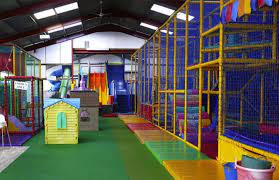
Discover the Magic of Indoor Play Areas for Children in the UK
Exploring the Benefits of Indoor Play Areas for Children
Indoor play areas are a haven for children to unleash their creativity, energy, and imagination in a safe and controlled environment. These vibrant spaces offer numerous benefits that contribute to a child’s physical, social, and cognitive development.
Physical Development
Indoor play areas provide children with opportunities to engage in active play, such as climbing structures, jumping on trampolines, and running through obstacle courses. These activities help improve their coordination, balance, strength, and overall physical fitness.
Social Development
Playing in indoor spaces allows children to interact with their peers, learn how to take turns, share toys, and collaborate on activities. These social interactions help them develop important communication skills, empathy, and teamwork abilities.
Cognitive Development
The stimulating environment of indoor play areas encourages children to explore new challenges, solve puzzles, and engage in imaginative play. This helps enhance their problem-solving skills, creativity, critical thinking abilities, and spatial awareness.
Sensory Stimulation
Many indoor play areas incorporate sensory experiences like colourful lights, textured surfaces, musical instruments, and interactive games. These sensory stimulations can benefit children with sensory processing disorders by providing them with a controlled environment to explore different sensations.
Safe Environment
Indoor play areas are designed with safety in mind, featuring soft padding on floors and equipment to reduce the risk of injuries. Parents can relax knowing that their children are playing in a secure space under the supervision of trained staff.
Educational Opportunities
Some indoor play areas offer educational workshops or themed activities that promote learning through play. Children can develop their literacy skills through storytelling sessions or enhance their knowledge of science through hands-on experiments.
In conclusion, indoor play areas offer a wealth of benefits for children’s development while providing a fun and engaging environment for them to explore. Whether it’s raining outside or you’re looking for a place to let your child’s imagination soar – indoor play areas are the perfect destination!
Essential Guide to Indoor Play Areas: Understanding Age Suitability, Safety, Supervision, and More
- What age range is suitable for indoor play areas?
- Are indoor play areas safe for children?
- Do parents need to stay with their children at indoor play areas?
- Are food and drinks allowed in indoor play areas?
- What should children wear when visiting an indoor play area?
- Can children with special needs participate in activities at indoor play areas?
- Do I need to book in advance for a visit to an indoor play area?
What age range is suitable for indoor play areas?
When it comes to the age range suitable for indoor play areas, there is typically a wide variety of activities catering to children of different ages. Most indoor play areas are designed to accommodate children ranging from toddlers to early teens, offering age-appropriate play zones and equipment. Younger children can enjoy soft play areas, sensory experiences, and gentle activities, while older kids may engage in more challenging obstacle courses, climbing walls, and interactive games. Ultimately, indoor play areas strive to provide a diverse range of activities that cater to the developmental needs and interests of children across various age groups, ensuring that there is something fun and engaging for everyone to enjoy.
Are indoor play areas safe for children?
Indoor play areas are designed with safety as a top priority to ensure a secure environment for children to play and explore. These spaces are equipped with soft padding on floors, age-appropriate equipment, and supervised by trained staff to minimise the risk of accidents. Regular maintenance checks and adherence to safety guidelines further enhance the safety measures in indoor play areas. Parents can have peace of mind knowing that their children can enjoy active play in a controlled setting where their well-being is prioritised.
Do parents need to stay with their children at indoor play areas?
At indoor play areas, the policy regarding parental supervision varies depending on the establishment. While some indoor play areas require parents to stay with their children at all times, others may offer drop-off services where children can be supervised by staff. It is important for parents to check the rules and regulations of each indoor play area before visiting to ensure that they are aware of whether parental supervision is required. Ultimately, the presence of parents can provide reassurance for both children and caregivers, fostering a sense of safety and connection in these dynamic play environments.
Are food and drinks allowed in indoor play areas?
In most indoor play areas, food and drinks policies vary depending on the facility’s rules and regulations. While some venues may allow outside food and beverages to be brought in, others may have restrictions or offer on-site catering options. It is important to check with the specific indoor play area you plan to visit regarding their policy on food and drinks to ensure a safe and enjoyable experience for all visitors. Proper disposal of waste and consideration for other guests are typically encouraged to maintain a clean and welcoming environment within indoor play areas.
What should children wear when visiting an indoor play area?
When visiting an indoor play area, it’s important for children to wear comfortable and practical clothing that allows them to move freely and safely. Opt for clothes that are easy to move in, such as leggings, t-shirts, and trainers. Avoid clothing with long strings or loose accessories that could get caught on equipment. It’s also a good idea to dress children in layers so they can adjust their clothing based on the temperature inside the play area. Don’t forget to bring along socks, as many indoor play areas require them for hygiene reasons. Overall, dressing children in suitable attire ensures they can fully enjoy their playtime while staying safe and comfortable.
Can children with special needs participate in activities at indoor play areas?
At indoor play areas, children with special needs are warmly welcomed and encouraged to participate in activities tailored to their unique abilities. Many indoor play areas strive to create inclusive environments where all children can feel comfortable and supported. Staff members are often trained to provide assistance and accommodations to ensure that children with special needs can fully enjoy the play experience. From sensory-friendly spaces to adaptive equipment, indoor play areas aim to cater to the diverse needs of every child, fostering a sense of belonging and empowerment for all participants.
Do I need to book in advance for a visit to an indoor play area?
Booking in advance for a visit to an indoor play area is often recommended to secure your spot and avoid disappointment, especially during peak times or on weekends. Many indoor play areas have limited capacity to ensure a safe and enjoyable experience for all visitors. By booking ahead, you can guarantee entry at your preferred time slot and streamline the check-in process upon arrival. It’s always a good idea to check the specific requirements of the indoor play area you plan to visit, as some may have online booking systems in place for added convenience.



